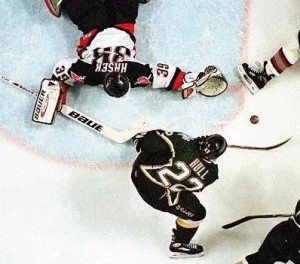This Day in Hockey History – June 19

Today in hockey history, a journeyman player with an interesting career is born, a few players are inducted into the Hall of Fame, a team names its first coach, and one of the most infamous moments in NHL history takes place.
June 19, 1947 – Former NHL center Walt McKechnie was born in London, Ontario. McKechnie might have set a “modern” record for playing on the most NHL teams that no longer exist: the Minnesota North Stars (now the Dallas Stars), California Golden Seals, Cleveland Barons, and Colorado Rockies (now the Devils). He also played on the Bruins, Red Wings, Capitals, and Leafs for a total of eight different teams in his 17-year career.
June 19 – The Hockey Hall of Fame announced two new classes:
1992 – Marcel Dionne, Bob Gainey, Lanny McDonald, and Woody Dumart.
2002 – Bernie Federko, Clark Gillies, Rod Langway, and builder Roger Neilson.
June 19, 2000 – Jacques Lemaire became the first coach in Minnesota Wild franchise history, giving him just four months until the start of the season to prepare his team.
June 19, 1999 – Eternal infamy was made on this day, and no, it wasn’t the start of a lockout or the birth of one commissioner Gary Bettman. And it just so happened that the event came on the cusp of a Stanley Cup championship…
Let’s set the scene: It’s the Stanley Cup Finals. The Buffalo Sabres are down three games to two in their series against the Dallas Stars. Both franchises are gunning for their first Stanley Cup. The teams are tied at 1 as regulation ends, and neither team can score in the first overtime period. They both fail to score in the second overtime period in this battle in Buffalo. The third overtime is about three-quarters finished, and players are getting tired. The kids are put to bed. Fans of these teams are getting more and more stressed, waiting for a decision to be reached. Trainers are running out of stiches. The organist’s fingers begin to numb. The Sabres know that one more goal against will end their season, and they definitely don’t want that goal to be a borderline, controversial violation of the rules.
Enter Brett Hull’s foot. The foot, along with the rest of Hull’s body, sneaks past the weary defensemen and finds itself alone in front of the crease. Hull, who is also tired, finds that the puck somehow had made its way to him. His deflection attempt is stopped. He battles for the loose puck with future Hall-of-Fame goaltender Dominik Hasek. A Buffalo defenseman desperately tries to knock his opponent out of the way with a body check, but his wild attempt misses. Amidst the brief chaos, Hull gathers the puck with his left skate and kicks it to his strong side, and the right-handed shot sweeps the puck barely past the helpless goalie and into the net. Game over after 114 minutes and 51 seconds of play. Series over. Dallas wins their first Stanley Cup, and Buffalo’s efforts are, essentially, for naught.
But there was a dispute. There was uncertainty on the Buffalo bench. Did Brett Hull violate a rule that should have negated the goal and kept the Sabres’ dream alive? A cloud of grey area manifested from the seemingly legal goal that would stay strong for several years and still taints the championship today.
Let’s rewind to 1999. There was a rule that, to summarize, prohibited a player from having any part of his body in the attacking crease without possession of the puck, and any goal scored that resulted from this violation would subsequently be waved off. Re-watch that video of the goal, and my description of it (here’s another video with a bird’s-eye-view angle). The puck was loose at various times and it could be argued either way as to whether Hull had full possession of the puck. His foot also was in the crease at various times. When Hull kicks the puck from his left skate to his stick just prior to the goal, was the time period in which he was not touching the puck considered possession? If so, the goal was correctly ruled legal, as his skate was in the crease while the puck was traveling to his stick, but if not, it should have been waved off.

I’m not going to argue; you decide. I’m not sure why it matters, because it was such a technicality that only mattered because of the color ice Hull was standing on, rather than the actual. Yet somehow, this possible technical violation of the rule has incited many Sabres fans, and fans throughout the league, enough to feel as if they were cheated.
Source: Hockey Hall of Fame

